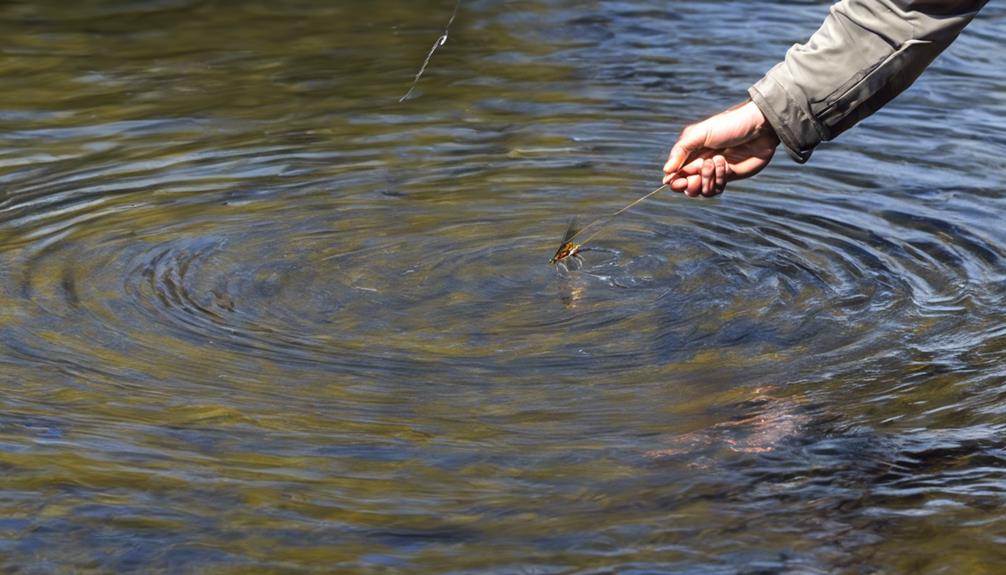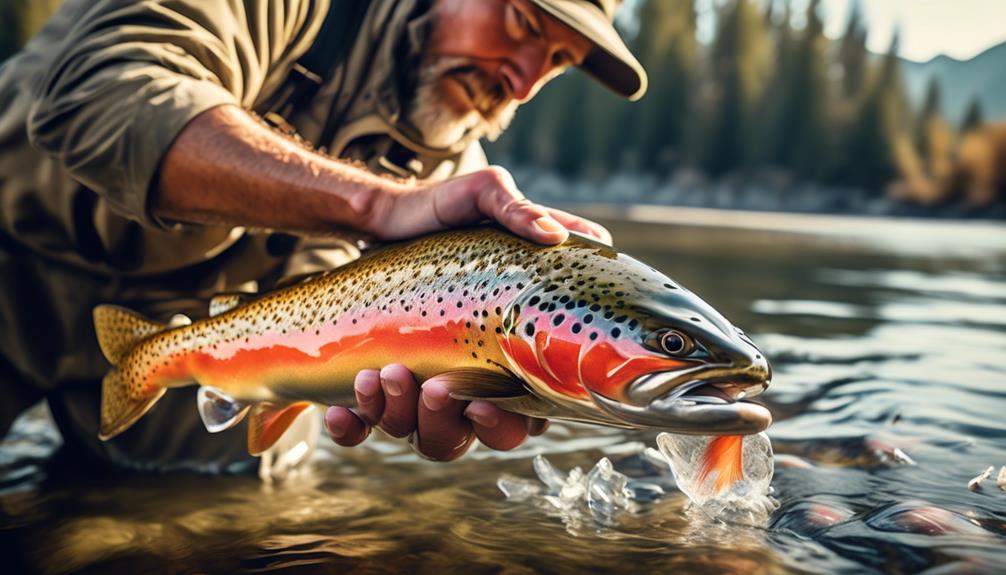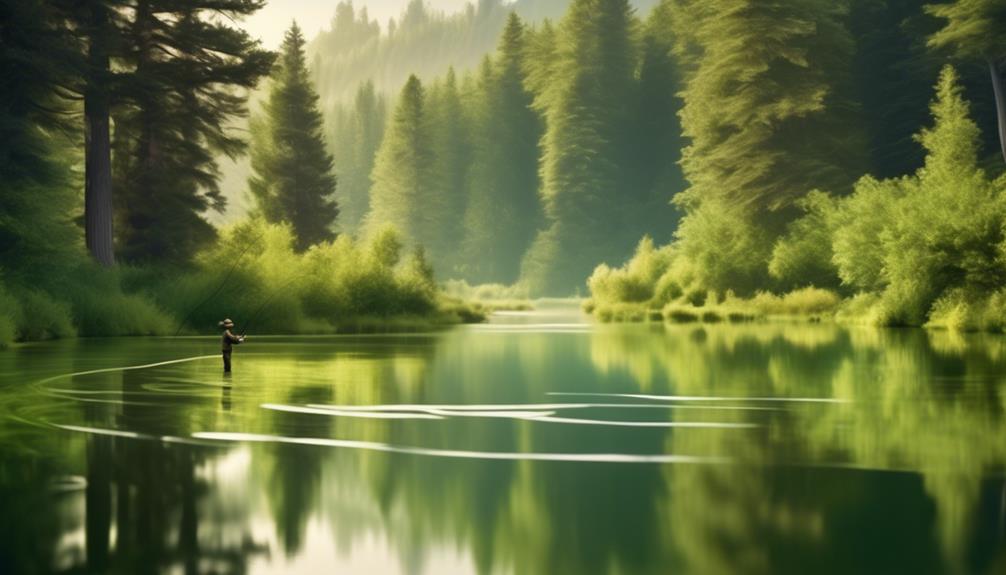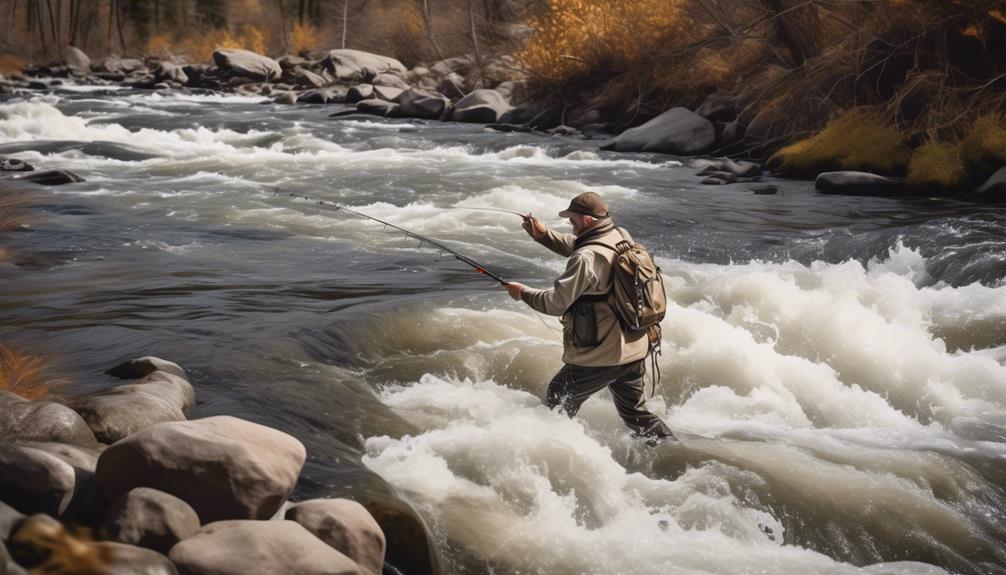When it comes to fly fishing, it's like learning a new language – intimidating at first, but with the right techniques, it becomes second nature.
You've got your gear ready, the sun is glistening on the water, and you're eager to cast your first line. But where do you begin?
Well, let's start by unraveling the mystery of fly fishing techniques for beginners. There's a whole world of strategies and skills waiting for you to explore, and by the end of this, you'll have a solid foundation to kickstart your fly fishing journey.
Gear and Equipment
When starting fly fishing, having the right gear and equipment is essential for your success and enjoyment on the water.
Let's start with the fly rod. As a beginner, it's crucial to choose a fly rod that suits the type of fishing you'll be doing. A versatile option is a 9-foot, 5-weight rod, which is suitable for various conditions and fish species. This type of rod provides a good balance between accuracy and power, making it easier for beginner anglers to cast and control the line.
Next, let's talk about reel selection. When it comes to choosing a reel, look for something that complements your fly rod. For a 5-weight fly rod, a corresponding reel that accommodates a 5-weight line is ideal. Consider the reel's weight and balance when paired with your rod. Additionally, ensure that the reel has a smooth drag system, as this is essential for playing and landing fish, especially when dealing with larger species.
As a beginner, it's easy to get overwhelmed by the myriad of gear options available. However, focusing on selecting a suitable fly rod and reel will set you on the right path. Remember, the goal is to have equipment that feels comfortable and empowers you to learn and improve your fly fishing skills.
Basic Casting Techniques
To improve your fly fishing skills, mastering basic casting techniques is essential for effectively presenting your fly to the fish. Line control is crucial in fly fishing, and mastering the basics of casting will greatly enhance your ability to control the movement of the line. One of the most important casting techniques to learn is the back cast.
This is the part of the cast where the line is sent backwards, away from the target, to load the rod and prepare for the forward cast.
When executing the back cast, it's important to keep the line under control to prevent tangles and ensure a smooth forward cast. As you bring the rod backward, maintain tension on the line with your line hand to keep it straight and controlled. This will allow for a more accurate and efficient forward cast. Additionally, having good line control during the back cast sets the stage for a powerful and precise delivery of the fly to the target.
Proper line control during the back cast also minimizes the risk of the line getting caught on surrounding obstacles such as trees or rocks. By mastering this basic casting technique, you'll be able to effectively manage the movement of the line and present your fly with greater accuracy, ultimately increasing your chances of a successful catch.
Understanding Fly Selection
Mastering the basics of casting, especially the back cast for line control, sets the foundation for understanding fly selection in fly fishing. Once you have honed your casting skills, it's time to delve into the art of choosing the right fly for the conditions and the fish you're targeting. Understanding fly selection involves considering various factors such as the types of insects present, water conditions, and the behavior of the fish.
Here are some essential aspects to grasp:
- Fly Tying Techniques and Fly Patterns: Learning about different fly tying techniques and understanding various fly patterns is crucial. This knowledge will allow you to appreciate the characteristics of different flies and how they imitate natural insects. It's also beneficial if you decide to try your hand at tying your own flies.
- Matching the Hatch and Imitating Insects: Observing the insects around the water body and understanding their life cycles is key to successful fly selection. Matching the hatch involves choosing a fly pattern that closely resembles the insects present, allowing you to effectively imitate natural food sources and increase your chances of enticing the fish to bite.
- Water Conditions and Fish Behavior: Pay attention to the water conditions, such as temperature and clarity, as these factors can influence the types of insects present and the fish's feeding patterns. Understanding how fish behavior changes in response to these conditions will help you select the most appropriate fly for the situation.
- Experimentation and Adaptation: Be open to experimenting with different fly patterns and adapting your approach based on the fish's response. Sometimes, a subtle change in fly selection can make a significant difference in your success on the water.
Understanding these aspects of fly selection will greatly enhance your fly fishing experience and increase your chances of landing that prized catch.
Reading the Water
How can you identify the best areas to target fish by understanding the nuances of water flow and structure?
When it comes to reading the water for fly fishing, paying attention to water currents and identifying feeding zones is crucial. To successfully target fish, you need to understand how water flows through a river or stream and how it affects the behavior of the fish. As a beginner, this skill is essential for increasing your chances of a successful fishing experience.
Understanding water currents is key to identifying feeding zones. Fish often position themselves in areas where they can conserve energy while still having access to food. These areas are typically where the current slows down, such as behind rocks or other natural obstructions. By observing the surface of the water, you can identify these feeding zones and plan your fly placement accordingly.
When it comes to fly placement, it's important to consider how the water currents will affect the movement of your fly. Placing your fly in a way that mimics the natural movement of insects in the water is essential for attracting fish. You'll want to place your fly just upstream of the feeding zone, allowing it to drift naturally into the target area.
Mastering the Roll Cast
By developing a solid understanding of the roll cast technique, you can enhance your fly fishing skills and adapt to different water conditions with greater ease. Mastering the roll cast is essential for effectively presenting your fly in situations where a traditional back cast isn't possible, such as when you have obstacles behind you or when dealing with windy conditions.
Here's how you can improve your roll cast technique:
- Roll Cast Mechanics: Understanding the mechanics of the roll cast is crucial. Start by bringing the rod tip low to the water's surface and then using a smooth, swift motion to lift the line off the water. As the line begins to straighten out behind you, move the rod forward to propel the line and fly toward your target. Practice this motion to achieve a fluid and efficient roll cast.
- Roll Cast Practice: Dedicate time to practice your roll cast regularly. Find an open area with still water to focus on your technique. Begin with short casts and gradually work on increasing the distance as you become more proficient. Pay attention to the timing and power of your movements to ensure a controlled and accurate cast.
- Adaptation to Water Conditions: Mastering the roll cast allows you to adapt to various water conditions. Whether you're fishing in tight spaces, dealing with obstacles, or facing windy conditions, the roll cast provides a versatile solution for presenting your fly effectively.
- Utilize Roll Cast Techniques: Incorporate roll cast techniques into your fishing repertoire. By mastering this skill, you'll have greater flexibility and success when encountering challenging casting scenarios.
Nymphing Strategies
To improve your fly fishing skills, consider incorporating effective nymphing strategies to enhance your success in catching fish.
Nymphing involves using artificial flies that resemble aquatic insects in their nymphal stage, which is a crucial part of a fish's diet. Two popular nymphing techniques are Euro nymphing and indicator nymphing.
Euro nymphing, also known as tight line nymphing, involves using a long, light rod and a thin, sensitive line to detect subtle strikes from fish. This technique requires a high level of line control and sensitivity to feel the nymph's contact with the riverbed.
On the other hand, indicator nymphing, also called Czech nymphing, uses a buoyant indicator attached to the leader to detect strikes. The indicator suspends the nymph at a specific depth, allowing you to detect subtle movements or pauses in the indicator's drift, indicating a fish has taken the fly.
In Euro nymphing, anglers typically use long leaders and thin tippets to achieve a more natural drift, while in indicator nymphing, the indicator helps control the depth and position of the nymph. Both techniques can be effective in different fishing scenarios, so it's essential to practice and become proficient in both methods.
When nymphing, be sure to pay attention to the speed and depth of the water, as well as the behavior of the fish.
Dry Fly Presentations

Mastering nymphing techniques prepares you to transition into the art of dry fly presentations as you advance in your fly fishing journey. Dry fly presentations are an exciting way to catch fish as you mimic the adult stage of aquatic insects floating on the water's surface.
Here are some tips and effective techniques to enhance your dry fly presentations:
- Observation is Key: Before you even make your first cast, take a moment to carefully observe the water. Look for rising fish, aquatic insect activity, and any clues that could help you anticipate where to present your dry fly.
- Accuracy and Stealth: When presenting a dry fly, accuracy is crucial. Try to approach the fishing spot stealthily, avoiding sudden movements that could spook the fish. Make precise casts to the target area, and avoid dragging the fly over the water.
- Matching the Hatch: Understanding the insects hatching in the area is fundamental. Use patterns that closely resemble the insects present to increase your chances of success.
- Mending and Drift Control: Proper mending and drift control are essential for a natural presentation. Practice mending your line to avoid unnatural drag that could alert the fish. Additionally, pay attention to the speed and direction of the current to achieve a lifelike drift.
Understanding Trout Behavior
Understanding trout behavior is crucial for successful fly fishing, as it allows you to anticipate their movements and feeding patterns. Trout are known for their selective feeding habits, making it essential to comprehend their behavior to effectively present your fly. Trout feeding behavior is influenced by a variety of factors, including the availability of food sources, water temperature, and time of day. Understanding these factors can help you choose the right fly pattern and presentation technique.
Trout are often found in clear, cold, and well-oxygenated water, and they typically prefer areas with cover, such as rocks, logs, and overhanging vegetation. These habitat preferences provide them with protection from predators and access to food. When approaching a potential feeding spot, be mindful of your movements, as trout are sensitive to vibrations and can easily be spooked.
Observing the surface of the water for rising fish can give you valuable insights into their feeding behavior. Trout rising to the surface to feed on insects can indicate the type of insects they're targeting and their feeding patterns. Additionally, paying attention to the behavior of other aquatic organisms, such as mayflies or caddisflies, can further aid in understanding trout feeding preferences.
Frequently Asked Questions
What Are Some Common Mistakes Beginners Make When Learning to Fly Fish?
When learning to fly fish, common mistakes include using improper equipment, like the wrong weight of fly rod. Improve technique by practicing casting in an open area, and avoid tangles by learning proper line management.
How Can Beginners Improve Their Timing and Accuracy When Casting?
To improve your timing and accuracy when casting, focus on fluid wrist movements and smooth acceleration. Keep your arm close to your body and aim for a straight line. Practice consistently to increase casting distance and accuracy.
Are There Any Specific Fly Patterns That Work Best for Certain Types of Water Conditions?
When selecting fly patterns, consider the water conditions. Different patterns work better in specific conditions, such as dry flies for calm waters and streamers for fast currents. Adapting to these conditions will improve your success.
What Are Some Tips for Effectively Fishing in Windy Conditions?
When fishing in windy conditions, use casting techniques that keep the line low to the water and minimize the impact of wind. Choose flies with weight or a more aerodynamic shape to aid in casting.
How Can Beginners Avoid Spooking Trout While Wading in the Water?
When wading to fish, avoid spooking trout by using stealth techniques. Move slowly to minimize water disturbance. Understand trout behavior and approach them properly to increase your chances of a successful catch.
Conclusion
So, grab your gear, practice your casting, and get out on the water.
With a little patience and persistence, you'll soon be mastering the art of fly fishing. Remember to pay attention to the water, the fish, and the flies you use. Keep practicing your techniques and learning from each trip.
Before you know it, you'll be a confident and successful fly fisher. Enjoy the journey and tight lines!



